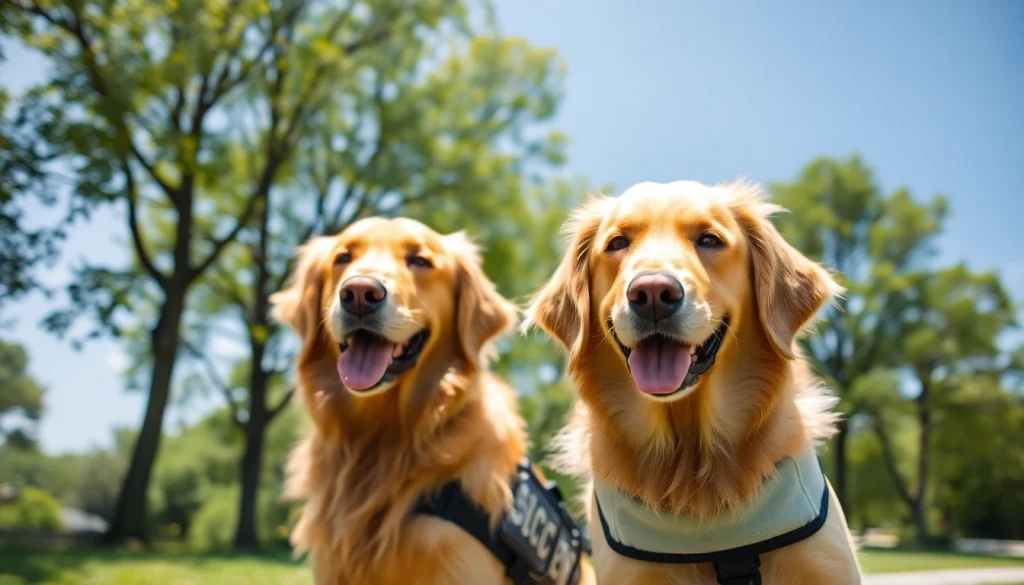Understanding Service Dogs
What is a Service Dog?
Service dogs are highly trained animals specifically bred to assist individuals with disabilities. These dogs are not your average pets; they perform crucial tasks that help their handlers live more independently. Unlike emotional support animals, service dogs are trained to perform specific tasks related to their handler’s disabilities. For instance, a service dog may guide a visually impaired person, retrieve objects for someone in a wheelchair, or alert a person prone to seizures when an episode is about to occur.
Different Types of Service Dogs
Service dogs can be categorized based on the specific needs of their handlers. The most common types include:
- Guide Dogs: Trained to assist individuals with visual impairments.
- Hearing Dogs: Alert individuals with hearing loss to sounds such as doorbells or alarms.
- Mobility Assistance Dogs: Help individuals with physical disabilities perform tasks and navigate their environment.
- Medical Alert Dogs: Trained to notify their handlers of medical emergencies, like diabetic lows or seizures.
- Psycho-Social Support Dogs: Assist those with mental health issues such as PTSD or anxiety by providing comfort and companionship.
Legal Rights and Regulations
In the United States, service dogs are protected under the Americans with Disabilities Act (ADA). This legislation allows service dogs to accompany their handlers in almost all public areas. It’s crucial to understand that these legal protections only apply to dogs that are trained to perform tasks that mitigate their handler’s disability. Additionally, handlers should be aware of state-specific laws that might offer additional protections or definitions of service dogs.
Reasons to Buy a Service Dog
Improved Quality of Life
One of the primary benefits of having a service dog is the significant improvement in the quality of life for individuals with disabilities. Service dogs provide physical assistance, which can lead to greater independence. For many, these dogs offer not just physical support but emotional stability as well. The bond formed with a service dog can lead to reduced feelings of isolation and an enhanced sense of belonging.
Training Benefits
Buying a trained service dog ensures that the animal can perform specific tasks that meet the unique needs of the handler. This training process varies widely: some organizations offer dogs that are fully trained and ready to assist, while others allow handlers to train their dogs in specific tasks. Either way, a well-trained service dog can help their owner navigate daily challenges more easily.
Companionship and Support
Beyond their functional roles, service dogs serve as steadfast companions. The emotional support that these dogs provide can be invaluable, especially for those managing chronic conditions or mental health issues. They foster a sense of connection and can encourage their handlers to engage with the world around them, reducing feelings of loneliness and depression.
How to Buy a Service Dog
Choosing the Right Type
The first step when considering to buy a service dog is identifying which type of service dog suits your specific needs. This decision primarily depends on the nature of your disability. Consultation with medical professionals, service dog trainers, or organizations specializing in canine assistance can provide valuable insights. Make a list of your daily challenges and consider what tasks you would benefit from a service dog performing.
Finding Reputable Breeders or Organizations
Once you’ve determined the type of service dog you require, the next step is to find reputable breeders or organizations. Research is essential here, as the quality of training can vary significantly between providers. Look for organizations accredited by recognized bodies that set standards for service dog training. Read reviews, check references, and ask about their training programs, philosophies, and the health checks they perform on their dogs.
Evaluating Training and Compatibility
When considering a service dog, it’s crucial to evaluate the training level of potential candidates. A good service dog should demonstrate reliability, obedience, and the ability to perform specific tasks on command. It’s advisable to participate in some initial training sessions or meet-and-greets to assess compatibility between you and the dog. This interaction helps both the handler and the dog to build a rapport, which can enhance the working relationship.
Financial Considerations
Cost of Service Dogs
The cost of purchasing a service dog can vary widely based on factors such as the dog’s breed, age, level of training, and the organization it comes from. Generally, fully trained service dogs can range anywhere from $15,000 to $30,000, which can be a significant investment for many families. It’s essential to factor in these costs when considering to buy a service dog, as well as potential ongoing expenses like healthcare, food, and training refreshers.
Financing Options and Grants
Financing options can make the cost of a service dog more manageable. Many organizations offer grants or subsidized fees for training and placing service dogs. Researching which organizations provide financial aid is crucial—they may have specific eligibility requirements or applications that need to be submitted. Crowd-funding can also be an option; sharing your story online can sometimes inspire others to contribute towards your service dog.
Insurance and Assistance Programs
Some health insurance companies may offer limited coverage for service dogs, particularly if they are deemed medically necessary. It’s worth checking with your provider to see if they offer any assistance or reimbursements related to service dog acquisition and care. Additionally, certain non-profit organizations focus on providing financial aid to individuals requiring service dogs, so exploring these resources is worthwhile.
Post-Purchase Responsibilities
Training After Acquisition
Even after purchasing a service dog, ongoing training is essential. Regular refreshers ensure the dog retains their obedience and specific task abilities. Many handlers choose to work with professional trainers to maintain their dog’s skills, while others may engage in self-directed training through workshops or online courses. Consistency is key to the bond between the handler and the service dog.
Healthcare and Nutrition
Like any pet, service dogs require proper healthcare and nutrition to thrive. Regular veterinary check-ups are essential to address any health concerns proactively. Alongside healthcare, ensuring the dog has a balanced diet specifically suited to their age, size, and energy level is critical. Consult with a veterinarian when choosing the right food, as proper nutrition directly influences the dog’s performance and well-being.
Maintaining the Bond with Your Service Dog
Creating and maintaining a strong bond with your service dog is vital. This can be achieved through regular interaction, playtime, and shared experiences outside of the working environment. Engaging in activities that both you and your dog enjoy not only improves the working relationship but also fosters a healthy emotional connection. Mutual trust and respect are the foundations of this bond, enhancing the effectiveness of the dog’s assistance.








